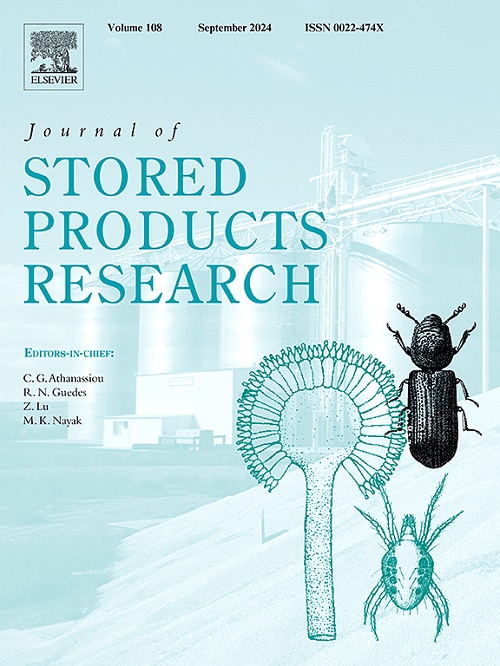Control of insect coffee bean weevils in Angelicae Dahuricae Radix storage by ozone treatment and its effect on the quality of Angelicae Dahuricae Radix
IF 2.7
2区 农林科学
Q1 ENTOMOLOGY
引用次数: 0
Abstract
The coffee bean weevil (Araecerus fasciculatus (De Geer)) is a storage pest with extreme destructive power that seriously harms Angelicae Dahuricae Radix, which has high medicinal value. Ozone (O3), an eco-friendly fumigant with rapid decomposition and residue-free properties, offers a promising alternative to conventional chemical pesticides. This study systematically evaluated the fumigation efficacy of O3 against adult A. fasciculatus and its impact on Angelicae Dahuricae Radix quality parameters. Results demonstrated complete mortality (100 %) in adult cohorts within 12 days post-exposure to 333.3 ppm O3 for 10 min, accompanied by rapid induction of flight incapacity and suppressed behavioral reactivity. Crucially, O3 treatment at ≤ 333.3 ppm preserved the chromatic stability of Angelicae Dahuricae Radix and maintained the pharmacologically active coumarin constituents - imperatorin, oxypeucedanin, and bergapten - within quality control thresholds. Therefore, this study suggests that an appropriate concentration of O3 can be developed as a fumigant for the control of adult coffee bean weevils, a storage pest of Angelicae Dahuricae Radix.
臭氧处理对白芷贮藏中咖啡豆象鼻虫的防治及其对白芷品质的影响
咖啡豆象鼻虫(Araecerus fasciculatus (De Geer))是一种严重危害白芷(Angelicae Dahuricae Radix)的具有极强破坏力的贮藏害虫,具有很高的药用价值。臭氧(O3)是一种具有快速分解和无残留特性的环保熏蒸剂,是传统化学农药的一个有前途的替代品。本研究系统评价了O3对成虫束夜蛾的熏蒸效果及其对白芷质量参数的影响。结果显示,在暴露于333.3 ppm O3 10分钟后的12天内,成年队列完全死亡(100%),伴随着飞行能力的快速诱导和行为反应性的抑制。重要的是,≤333.3 ppm的O3处理保持了白芷的颜色稳定性,并将药理活性香豆素成分-欧前胡素,氧去黄嘌呤和橙汁甲苷-保持在质量控制阈值内。因此,本研究表明,适宜浓度的O3可作为熏蒸剂防治白芷储藏害虫咖啡豆象鼻虫成虫。
本文章由计算机程序翻译,如有差异,请以英文原文为准。
求助全文
约1分钟内获得全文
求助全文
来源期刊
CiteScore
5.70
自引率
18.50%
发文量
112
审稿时长
45 days
期刊介绍:
The Journal of Stored Products Research provides an international medium for the publication of both reviews and original results from laboratory and field studies on the preservation and safety of stored products, notably food stocks, covering storage-related problems from the producer through the supply chain to the consumer. Stored products are characterised by having relatively low moisture content and include raw and semi-processed foods, animal feedstuffs, and a range of other durable items, including materials such as clothing or museum artefacts.

 求助内容:
求助内容: 应助结果提醒方式:
应助结果提醒方式:


